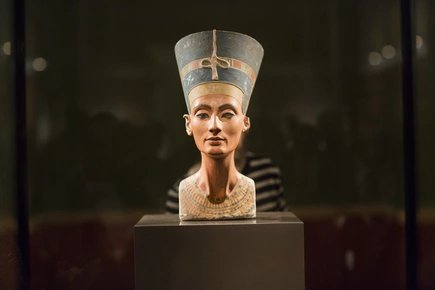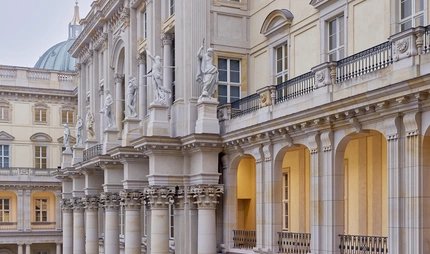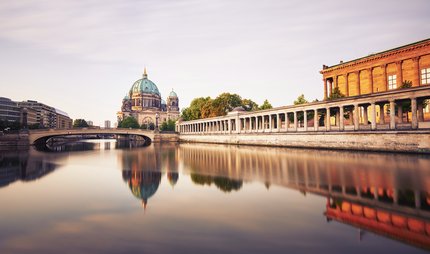
Asian Art Museum in the Humboldt Forum
From Chinese porcelain to Japanese paintings
The artistic and cultural artefacts at the Asian Art Museum are as diverse as the Asian cultures themselves: This is one of the most important collections worldwide of artworks from the Indo-Asian cultural sphere, from the 4th century BCE to the present day. The collection has been housed in the upper floors of the Humboldt Forum since 2021, along with the Ethnological Museum.
The incredible artworks from Asia have drawn excited museum visitors for many decades, back when they were located in Berlin-Dahlem. They then disappeared from the scene for a few years to undergo extensive restoration. They can now be viewed in the spacious exhibition areas on the third floor of the Humboldt Forum.

Asian masterworks behind restored palace facades
These testaments to the largest continent’s cultures come from a period spanning from the 5th century BCE to the present day. Artefacts from southern, south-eastern, eastern, and central Asia are displayed. The primary focus rests on early Indian sculpture, art and culture on the Silk Road, and sacral art from China, Japan, and Korea.

One special highlight is the world-famous Turpan Collection, named for one of the four Prussian royal expeditions to the northern Silk Road (modern-day Xinjiang, People’s Republic of China) between 1902 and 1914: Its centrepiece is a true-to-scale reproduction of a reconstructed cave temple, Kizil Cave 123, known as the “Cave with the ring-bearing doves”, adorned with original murals.
Spheres of influence and living environments
The art on display reflects exciting details about views on life and spirituality, as well as early court life and spheres of influence in Asian cultures. Buddhist concepts of life from India, the ascetic philosophy of the Jains, and the complex pantheon of Hinduism have inspired and shaped the masterworks shown here.
Aspects of everyday life, such as getting together for tea, are presented in the contemporary Japanese tea shop designed by Jun Ura / Ura Architects, tea master Sokyu Nara, and contemporary artists in 2019. The tea shop contains a preparation room and a main room with a fireplace, where tea ceremonies can be held. Visitors can leave their daily lives at the door and immerse themselves in traditional Japanese tea customs.

Chinese royal art, such as a throne made from lacquered rosewood, and countless mother-of-pearl, gold, and silver items, are on display in a one-of-a-kind throne room designed by world-renowned Chinese architect Wang Shu. Beneath the ceiling is a striking, gigantic roof structure of a Chinese pagoda containing 1,300 screwed-in components made of poplar. A large, stainless steel niche in the wall contains a royal mural from the 18th century, measuring 5.43 x 10.15 metres.
In September 2022, the last large exhibition area of the Humboldt Forum, the East Wing, also opened, and thus another part of the exciting object collections on Asia can be experienced in the Museum of Asian Art.

Not to be missed:
- Processional steer "Nandi", colourfully painted wood, south India, 17th century
- Jewellery box, ivory, Ceylon, 16th century
- Cave with the ring-bearing doves, original murals, China, 6th/7th century
- Folding screen "Pines, cedars and birds", Indian ink and paint on gold leaf, Japan, 17th century
- Relief "Mara’s attack on buddha", slate, Pakistan, 2nd/3rd century

Your visit
The Asian Art Museum in the Humboldt Forum is fully accessible. It is best reached via the newly opened U-Bahn station Museumsinsel with the U5 line. The nearest S-Bahn stations are Friedrichstraße and Hackescher Markt (S3, S5, S7, S9). If you are arriving by bus, get off at the stops Lustgarten or Staatsoper. The tram also stops nearby at the stations Am Kupfergraben or Hackescher Markt.
Visit our new Berlin Tourist Information directly in the Humboldt Forum with its new, wide range of services, and admire the large, historical model of the city.
More culture in the area
As you are in the heart of the city, in the new cultural hub of Mitte between the Fernsehturm and Brandenburg Gate, you are surrounded by sights to see. The Berliner Dom in the Lustgarten directly opposite, and all the buildings and museums on the world-famous Berlin Museum Island, which is a UNESCO World Heritage Site, are especially interesting. You can also stroll along the Boulevard Unter den Linden toward Brandenburg Gate.
While doing so, take a look at the many monuments: after all, Berlin is the Sculpture Capital.
Opening hours
Wednesday to Monday 10.30 a.m. to 6.30 p.m.
Tuesday closed



